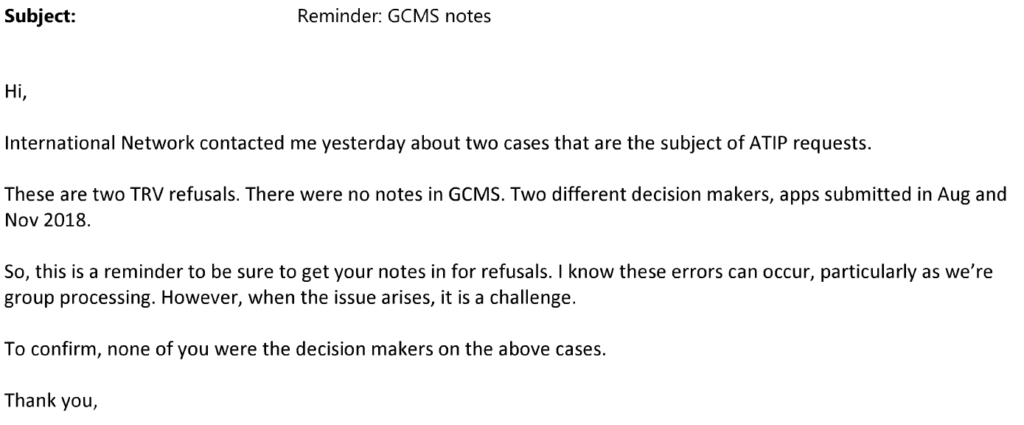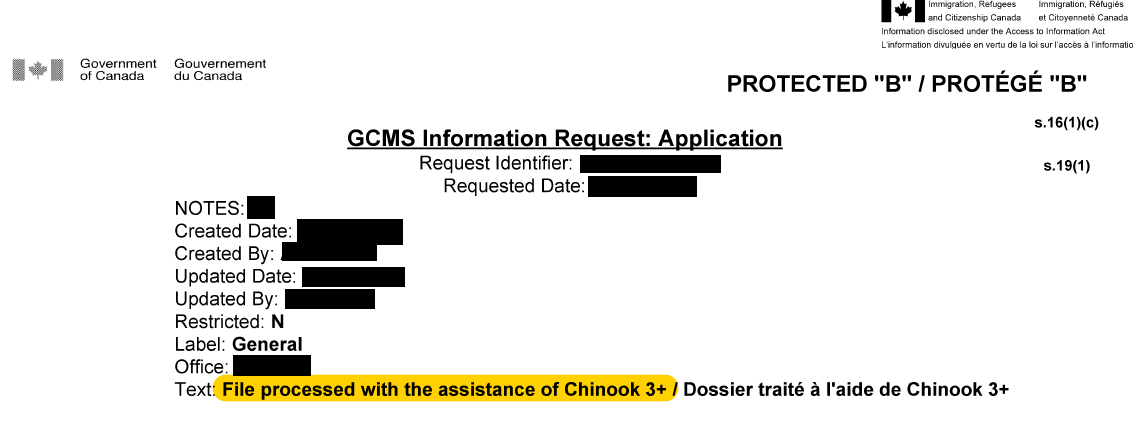Much has already been written about IRCC’s Excel based tool called Chinook. This blog article provides some Chinook resources obtained directly from IRCC.
- Chinook is a Microsoft Excel-based tool developed by Immigration, Refugees and Citizenship Canada (IRCC) for temporary resident application processing to increase efficiency and to improve client service by decreasing the impacts of system and broadband latency, thus improving processing times.
- Chinook displays information stored in the Global Case Management System (GCMS), IRCC’s processing system and system of record, in a more user-friendly way, allowing for increased GCMS user productivity.
- Chinook is a tool designed to simplify the visual representation of a client’s information. It does not utilize artificial intelligence (AI), nor advanced analytics for decision-making, and there are no built-in decision-making algorithms.
- It is always an IRCC officer, not the Chinook tool, that makes the final decision on an application. Chinook does not assess or make decisions on applications. Officers continue to review all client-submitted information to ensure informed and fair decisions. The use of Chinook does not lead to a less thorough review of applications, nor does it change the way decisions are made, it simply offers a consolidated view in a more user-friendly way, instead of a multiple screen layout of the application’s information.
- Chinook is not a mandatory tool for IRCC officers and does not fundamentally alter the decision-making process.
- The Chinook tool was piloted in processing offices in 2018 and officially launched in 2019. It reduces the amount of time spent uploading and reviewing information on multiple screens in GCMS. This is especially important in countries where computer bandwidth is slow, which would otherwise slow down application processing.
- Chinook is built in a modular way, allowing it to administratively support different steps in the process of assessing an application, depending on the module used. The various modules can assist IRCC with steps such as file management, indicator management, and pre- and post-decision management.
- IRCC officers may use the Chinook tool for assessing temporary resident visa, study permit and work permit applications. In part, Chinook extracts temporary resident application information from the client’s submitted application in GCMS and presents it in a user-friendly fashion. This streamlines administrative steps that would otherwise be required if applications were processed directly within the GCMS environment.
- The Immigration Refugee Protection Act and Regulations (IRPA/IRPR) are the basis for the decisions rendered by officers. Decisions are based on the officer review and made by the officer. Chinook does not change the way decisions are made; it is always an officer – not the Chinook spreadsheet – that makes final decisions and provides the rationale for them. Chinook supports decision-makers and IRCC staff and is not used to make or recommend decisions.
- Chinook does not store any data or client information. This is a privacy-centric approach so that IRCC is not creating a new database of personal information. Officers must record all decisions in GCMS, which remains the system of record.
- Chinook users within processing offices provide all necessary training and support related to Chinook, prior to other officers having access to the tool. Supplementary support is available through the use of standardized training materials, such as user manuals and recorded training videos.
- In December 2020, performance of Chinook was measured through a sample study for overseas migration offices. The results determined there was an 18-30% gain in efficiency, decreasing the impacts of system and broadband latency and allowing for shorter review time per application hence increasing productivity.
- Chinook is a tool designed to simplify the visual representation of a client’s information. It does not utilize artificial intelligence (AI), nor advanced analytics for decision-making, and there are no built in decision-making algorithms. IRCC’s advanced analytics and automation systems operate independently of Chinook, and they are reviewed routinely to ensure they are working as intended and align with the Government of Canada’s Directive on Automated Decision-Making.
- In the Ocran test case chosen to address the issue of completeness of Certified Tribunal Records (CTR) in Chinook cases, the Court dismissed the application for judicial review on February 10, 2022. The Court did not rule on the CTR issue specifically, as it was not in direct dispute between the parties.
- Importantly, visa refusal and approval rates will vary from year to year. It is up to the applicant to satisfy the IRCC officer that they meet the requirements for the visa or permit they seek. All applications are considered on a case-by-case basis, based on the specific facts presented by the applicant; Chinook does not fundamentally alter the decision-making process.
Source: IRCC
Notable issues with bulk processing
GCMS Notes – In 2019, it was discovered by IRCC that some visa refusals were made without any GCMS notes on file.

Chinook version displayed in GCMS – The Chinook version is displayed in GCMS so that IRCC’s Litigation Management department can quickly identify cases that were processed using Chinook. This is because the way that Litigation Management approaches and handles cases that were processed using Chinook is different from the way they approach and handle cases that were not processed using Chinook. For example, if an application was processed using Chinook, Litigation Management may need to take additional steps to review the case. Additionally, they may need to follow different procedures when communicating with the applicant or their representative.
Federal Court of Canada on Chinook – In June 2023 the Federal Court of Canada judge noted that “I note that Ms. Khosravi’s application was “processed with the assistance of Chinook 3+”. I do not know if the shortcomings outlined above result from the use of this tool. I will simply say that the use of assisted decision-making tools does not relieve officers from the duty to fully consider an application, most importantly the study plan. If the use of such a tool gives the officer a truncated vision of the application, the resulting decision may well be unreasonable.“
In another Federal Court case, the judge noted that “the officer’s notes consist largely of boilerplate statements that we see repeatedly in study permit decisions and that appear to be generated by the Chinook software.”
What is Cumulus?
Cumulus is a processing tool used by IRCC immigration officers which offers a consolidated view of applications.
Cumulus offers a consolidated view of an application. This means that all of the information about an application is displayed in one place, which can make it easier for officers to find the information they need. Cumulus also seeks to provide a more user-friendly and expedited processing experience for officers. This is done by making the user interface more intuitive and by streamlining the processing workflow.
The Enterprise Data Warehouse (EDW) extracts data from the Global Case Management System (GCMS). This data is then pulled into the Application and Activity Module (AAM). The AAM is where officers retrieve their assigned applications. Once an officer has retrieved an application, they can process it within the Cumulus environment.
Applications that are assessed within Cumulus will still need to be copy and pasted into GCMS once complete. This is because GCMS is the system of record for all applications.
Here are some of the benefits of using Cumulus:
- Consolidated view of an application: This makes it easier for officers to find the information they need.
- More user-friendly and expedited processing experience: This can save officers time and help them to process applications more efficiently.
- Integration with GCMS: This ensures that all applications are processed in a consistent and accurate manner.
- Support for office-specific processing procedures: This helps to ensure that all applications are processed in accordance with the specific requirements of each office.
Cumulus is a powerful tool that can help IRCC officers be more efficient and effective in their work.
What is Lighthouse?
Lighthouse (formerly known as Watchtower) is an AI-based risk indicator solution that has been developed by IRCC to automatically and comprehensively extract risk and fraud patterns from source data from the Global Case Management System (GCMS). The tool does not involve automated decision-making. In its initial pilot, Lighthouse uncovered over 800 unique risk patterns, some of which led to the identification of larger-scale fraud trends. The responsibility of development, implementation, and maintenance of Lighthouse lies with the Advanced Analytics Solutions Centre team within the Operational Planning and Performance Branch of IRCC.



